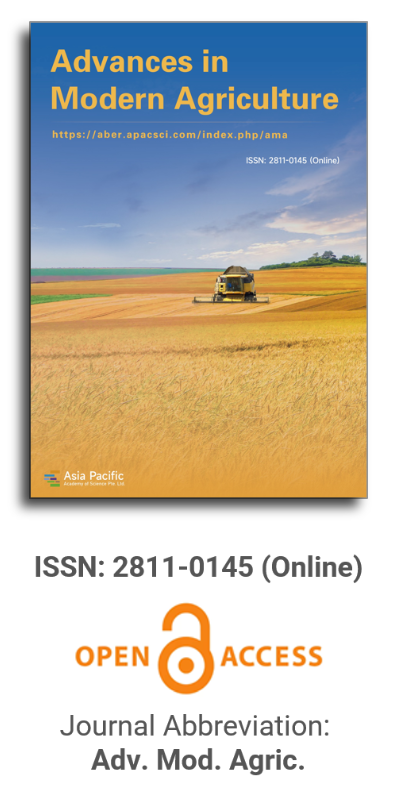


Yield potency assessment and characters association of promising lines of mustard (Brassica rapa L.) in southern region of Bangladesh
Vol 4, Issue 2, 2023
VIEWS - 4873 (Abstract)
Download PDF
Abstract
Keywords
References
- Ahmed Z, Kashem MA. Performance of mustard varieties in haor area of Bangladesh. Bangladesh Agronomy Journal 2017; 20(1): 1–5. doi: 10.3329/baj.v20i1.34875
- USDA. Bangladesh: Oilseeds and products annual. Available online: https://www.fas.usda.gov/data/bangladesh-oilseeds-and-products-annual-3 (accessed on 30 March 2022).
- Aziz MA, Rahman AKMM, Chakma R, et al. Performance of mustard varieties in the hilly areas of Bangladesh. Journal of Experimental Biosciences 2011; 2(2): 7–10.
- Das S, Tejani DN, Patel JC, et al. Effect of weather parameters on population dynamics of mustard aphid. International Journal of Current Microbiology and Applied Science 2019; 8(4): 1648–1653. doi: 10.20546/ijcmas.2019.804.192
- Sehgal A, Reddy KR, Walne CH, et al. Climate stressors on growth, yield, and functional biochemistry of two Brassica species, Kale and Mustard. Life 2022; 12(10): 1546.doi: 10.3390/life12101546
- Uddin MS, Talukdar MMR, Khan MSI, et al. Evaluation of mustard genotypes under late sowing condition in the southern region of Bangladesh. Journal of Scientific Research 2009; 1(3): 667–672. doi: 10.3329/jsr.v1i3.2576
- Agriculture Information Service (AIS). Government of the People’s Republic of Bangladesh. Available online: http://www.ais.gov.bd/site/ekrishi/da8c8a9e-683a-4f3e-ab89-ac9c65fddf64 (accessed on 7 April 2023).
- Tridge. Export & import trends in food & agriculture. Available online: https://www.tridge.com/ (accessed on 31 October 2023).
- Bangladesh Agricultural Research Institute. BARI Annual Report (2021–2022). Oilseed Research Centre; 2022.
- Khaliqi A, Rafii MY, Mazlan N, et al. Genetic analysis and selection criteria in Bambara groundnut accessions based yield performance. Agronomy 2021; 11(8): 1634. doi: 10.3390/agronomy11081634
- Khan MH, Rafii MY, Ramlee SI, et al. Genetic analysis and selection of Bambara groundnut (Vigna subterranea [L.] Verdc.) landraces for high yield revealed by qualitative and quantitative traits. Scientific Reports 2021; 11(1): 7597. doi: 10.1038/s41598-021-87039-8
- Fayyaz L, Amin NU. Genetic variability among advanced lines of Brassica. Pakistan Journal of Botany 2015; 47(2): 623–628
- Bazzaz MM, Hossain A, Farooq M, et al. Phenology, growth and yield are strongly influenced by heat stress in late sown mustard (Brassica spp.) varieties. Pakistan Journal of Botany 2020; 52(4): 1189–1195. doi: 10.30848/PJB2020-4(44)
- Sharif MAR, Haque MZ, Howlader MHK, Hossain MJ. Effect of sowing time on growth and yield attributes of three mustard cultivars grown in Tidal Floodplain of Bangladesh. Journal of the Bangladesh Agricultural University 2016; 14(2): 155–160. doi: 10.3329/jbau.v14i2.32689
- Helal MU, Islam N, Kadir M, Miah NH. Performance of rapeseed and mustard (Brassica sp.) varieties/lines in north-east region (sylhet) of Bangladesh. Advances in Plants & Agriculture Research 2016; 5(1): 457–462. doi: 10.15406/apar.2016.05.00168
- Mojena R. Hierarchical grouping methods and stopping rules: An evaluation. The Computer Journal 1977; 20(4): 359–363. doi: 10.1093/comjnl/20.4.359
- Khan MH, Rafii MY, Ramlee SI, et al. Unveiling genetic diversity, characterization, and selection of Bambara Groundnut (Vigna subterranea L. Verdc) genotypes reflecting yield and yield components in tropical Malaysia. BioMed Research International 2022; 2022: 6794475. doi: 10.1155/2022/6794475
- Khan MH, Rafii MY, Ramlee SI, et al. Genetic variability, heritability, and clustering pattern exploration of Bambara groundnut (Vigna subterranea L. Verdc) accessions for the perfection of yield and yield-related traits. BioMed Research International 2020; 2020: 2195797. doi: 10.1155/2020/2195797oducts-annual-3
Supporting Agencies
Copyright (c) 2023 Mahmudul Hasan Khan, B. C. Kundu, M. Shalim Uddin, M. Rafiqul Islam, M. Aktar-Uz-Zaman, M. Ahmed, Razi Uddin, M. Rashedul Islam, A. K. Das, M. G. Rahman
License URL: https://creativecommons.org/licenses/by/4.0/

This site is licensed under a Creative Commons Attribution 4.0 International License (CC BY 4.0).

Prof. Zhengjun Qiu
Zhejiang University, China

Cheng Sun
Academician of World Academy of Productivity Science; Executive Chairman, World Confederation of Productivity Science China Chapter, China
Indexing & Archiving
In the realm of modern agriculture, the integration of cutting-edge technologies is revolutionizing the way we approach sustainable farming practices. A recent study published in Advances in Modern Agriculture titled "Classification of cotton water stress using convolutional neural networks and UAV-based RGB imagery" has garnered significant attention for its innovative approach to precision irrigation management. Conducted by researchers from Institute of Data Science and the AgriLife Research and Extension Center of Texas A&M University (authors's information is below). This study introduces a novel method for classifying cotton water stress using unmanned aerial vehicles (UAVs) and convolutional neural networks (CNNs), offering a powerful solution for optimizing water use in agriculture.
Modern agricultural technology is evolving rapidly, with scientists collaborating with leading agricultural enterprises to develop intelligent management practices. These practices utilize advanced systems that provide tailored fertilization and treatment options for large-scale land management.
This journal values human initiative and intelligence, and the employment of AI technologies to write papers that replace the human mind is expressly prohibited. When there is a suspicious submission that uses AI tools to quickly piece together and generate research results, the editorial board of the journal will reject the article, and all journals under the publisher's umbrella will prohibit all authors from submitting their articles.
Readers and authors are asked to exercise caution and strictly adhere to the journal's policy regarding the usage of Artificial Intelligence Generated Content (AIGC) tools.
Asia Pacific Academy of Science Pte. Ltd. (APACSCI) specializes in international journal publishing. APACSCI adopts the open access publishing model and provides an important communication bridge for academic groups whose interest fields include engineering, technology, medicine, computer, mathematics, agriculture and forestry, and environment.



.jpg)
.jpg)

.jpg)
